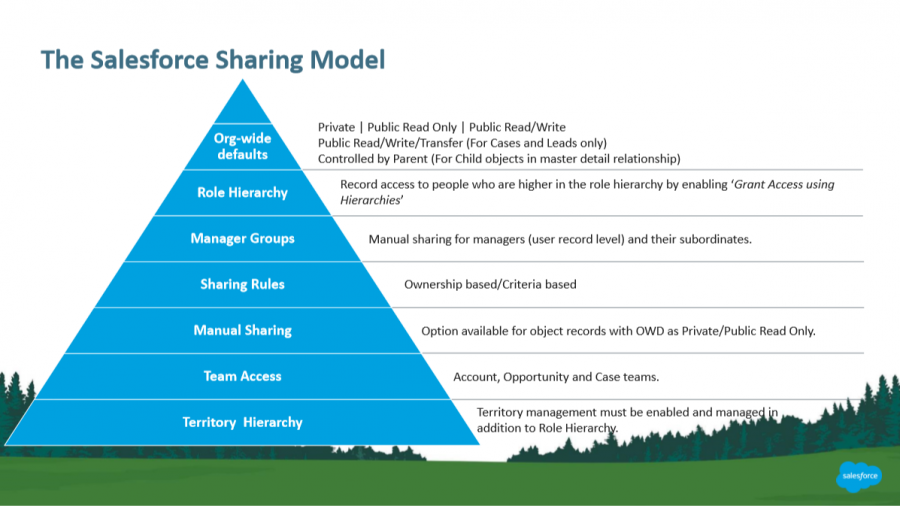Sharing Objects Part 1
Contents
[NOTE] Updated 5 years ago. This article may have outdated content or subject matter.
What is sharing in Salesforce?
Sharing is the act of granting a user or group of users permission to perform a set of actions on a record or set of records. Sharing access can be granted using the Salesforce user interface and Lightning Platform, or programmatically using Apex. This post is apart of the Salesforce Platform Developer 2 certification journey, specifically Salesforce Fundamentals and as such will be based on programmatic sharing within apex. listed below are some of the different topics that will be discussed.
- Types of sharing
- Implementing programmatic sharing
Managed Sharing
Managed sharing involves sharing access granted by the Lightning Platform based on record ownership, the role hierarchy, and sharing rules.
Record Ownership
Each record is owned by a user or optionally a queue for custom objects, cases, and leads, etc. The record owner is automatically granted Full Access, allowing them to view, edit, transfer, share, and delete the record.
Role Hierarchy
The role hierarchy enables users above another user in the hierarchy to have the same level of access to records owned by or shared with users below. Consequently, users above a record owner in the role hierarchy are also implicitly granted Full Access to the record, though this behavior can be disabled for specific custom objects. The role hierarchy is not maintained with sharing records. Instead, role hierarchy access is derived at runtime. For more information, see “Controlling Access Using Hierarchies” in the Salesforce online help.
Sharing Rules
Sharing rules are used by administrators to automatically grant users within a given group or role access to records owned by a specific group of users. Sharing rules cannot be added to a package and cannot be used to support sharing logic for apps installed from AppExchange. Sharing rules can be based on record ownership or other criteria. You can’t use Apex to create criteria-based sharing rules. Also, criteria-based sharing cannot be tested using Apex. >All implicit sharing added by Force.com managed sharing cannot be altered directly using the Salesforce user interface, SOAP API, or Apex.
User Managed Sharing, also known as Manual Sharing
User managed sharing allows the record owner or any user with Full Access to a record to share the record with a user or group of users. This is generally done by an end-user, for a single record. Only the record owner and users above the owner in the role hierarchy are granted Full Access to the record. It is not possible to grant other users Full Access. Users with the “Modify All” object-level permission for the given object or the “Modify All Data” permission can also manually share a record. User managed sharing is removed when the record owner changes or when the access granted in the sharing does not grant additional access beyond the object’s organization-wide sharing default access level.
Apex Managed Sharing
Apex managed sharing provides developers with the ability to support an application’s particular sharing requirements programmatically through Apex or the SOAP API. This type of sharing is similar to managed sharing. Only users with “Modify All Data” permission can add or change Apex managed sharing on a record. Apex managed sharing is maintained across record owner changes.
In the Salesforce user interface, the Reason field on custom object specifies the type of sharing used for the record.
Access Levels
When determining a user’s access to a record, the most permissive level of access is used
| Access Level | API Name | Description |
|---|---|---|
| Private | None | Only the record owner and users above the record owner in the role hierarchy can view and edit the record. This access level only applies to the AccountShare object. |
| Read Only | Read | The specified user or group can view the record only. |
| Read/Write | Edit | The specified user or group can view and edit the record. |
| Full Access | All | The specified user or group can view, edit, transfer, share, and delete the record. This access level can only be granted with managed sharing. |
Sharing Considerations
If a trigger changes the owner of a record, the running user must have read access to the new user record, if the trigger was started through the following - API - Standard user interface - Standard visualforce controller - Class defined with the with sharing keyword
If a trigger is started through a class that’s not defined with the with sharing keyword, the trigger runs in system mode. In this case, the trigger doesn’t require the running user to have specific access.
Author Remario Richards
Modified February 20, 2020

